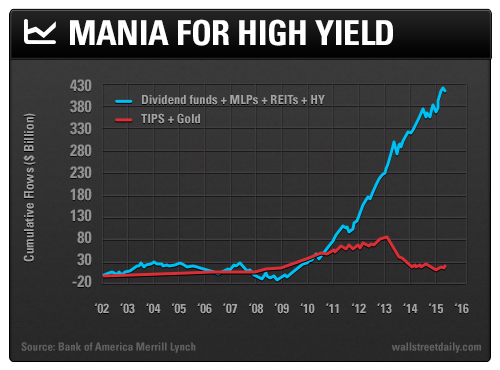I often caution against running with the investing herd, especially when it comes to higher-yielding securities.
Well, Bank of America recently put out a report warning about “a cleansing drop in asset prices.” Sure enough, the popularity of various high-yield investments is one of the five potential catalysts – which the analysts have combined into an ominous C.R.A.S.H. acronym.
The report includes perhaps the most striking depiction of the “reach for yield” phenomenon I’ve ever seen…

Cumulative flows into dividend funds, master limited partnerships (MLPs), real estate investment trusts (REITs), and high-yield bonds have totaled $413 billion since 2002.
The popularity of these investments, along with the associated fund flows, has adversely impacted their risk-reward propositions. Returns are effectively pulled forward in time as investors chase prices higher, thereby lowering yields. Meanwhile, stock valuations become inflated, hampering performance.
For example, in July 2014, I noted that Procter & Gamble Company (NYSE:PG), a Dividend Aristocrat, had become expensive relative to its historical valuation. Despite a nice yield and solid underlying businesses, the stock had underperformed since mid-2013 – and it continues to underperform.
Since my article, PG has gained 3.2% on a total-return basis (including dividends), compared with an advance of 9.1% for the S&P 500. The stock continues to work off its high valuation, but many investors are complacent.
Indeed, high-yielding stocks and other “crowded trades” are particularly vulnerable if the herd was to get spooked, as BofAML has illustrated.
However, there’s one corner of the market that’s conspicuously absent from the above chart: preferred stocks. They’re perhaps the only higher-yielding assets which are truly out-of-favor.
Because they’ve been overlooked during this high-yield mania (at least so far), yields offered by preferred stocks are still relatively high in this low-yield environment. Many preferred stocks are still yielding just as much as they were in 2010, when the U.S. 10-year Treasury rate was above 3.5%.
Back in January 2014, we highlighted a special type of preferred stock with a floating dividend.
As it turns out, there’s now a convenient way to own a basket of these floating (variable) rate preferreds via an exchange-traded fund (ETF). The PowerShares Variable Rate Preferred ETF (VRP), which holds nearly 100 preferred stocks and similar “hybrid securities,” has a trailing 12-month yield of 4.6%.
That’s a slightly lower return than traditional preferred stock funds, which behave more like bonds with long durations (sensitivity to interest rates). Variable-rate preferreds, on the other hand, tend to trade more like bonds with shorter durations. However, this lower risk profile is going to be welcome for many conservative investors.
This way, we can earn a relatively high yield and still be protected from a “cleansing” crash that BofAML has warned about.
By investing in variable-rate preferreds, you can be a trailblazer rather than a herd follower.
Safe (and high-yield) investing,
